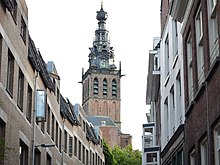Stevenskerk (Nijmegen)
The Stevenskerk or Grote Kerk ( German Great Church ) is the historic main parish church of the Dutch city of Nijmegen (German Nijmegen ) in the province of Gelderland . Today the church belongs to the ecumenical city parish. It is named after the holy arch-martyr Stephen .
history
The first parish church in Nijmeg was dedicated to St. Gertrudis and was located in the area of the castle. In 1254, the St. Aposteln Abbey in Cologne, as pastor, made land available in the center of the city on which a new church could be built. After almost twenty years, in 1273 it was consecrated to Saint Stephen. This original Romanesque basilica was given a west tower around 1300, a Gothic choir around the middle of the 14th century and wider Gothic aisles around 1400. Between 1423 and 1456, Master Gisbert Schairt built an ambulatory . In 1475 a collegiate chapter was established at the church.
In the 16th century, a transept was built in late Gothic forms. After the church's furnishings had already fallen victim to the iconoclasm, the Reformation was finally introduced in 1591; the pen was picked up. The planned renovation of the western nave was no longer carried out. In 1604/05 the church tower received its characteristic finish in forms of the Renaissance . The monumental royal organ was built by Christian Ludwig König in 1774–1776 . In 1944 the Stevenskerk was badly damaged in the bombing of Nijmegen. The reconstruction took place from 1953 to 1969.
Organs
The Stevenskerk has four organs : the choir organ dates from around 1700, the Assendelf organ from 1750, the royal organ from 1773–1776, and the Clerinx organ from 1848. With the exception of the Clerinx organ, which has a has a new organ, all instruments have the status "Rijksmonument".
The largest, most famous organ is the "King's Organ". The instrument was built between 1773 and 1776 by the Cologne organ builder Christian Ludwig König (1717–1789). The instrument has 55 registers (approx. 3,600 pipes ) on three manuals and a pedal .
|
|
|
|
||||||||||||||||||||||||||||||||||||||||||||||||||||||||||||||||||||||||||||||||||||||||||||||||||||||||||||||||
- Coupling I / II, III / II, I / P, II / P
literature
- Friedrich Gorissen : Nijmegen. Kleve 1956 (Niederrheinischer Städtatlas II.1).
- Herman de Heiden: De St. Stevenskerk te Nijmegen. Geschiedenis, bouwgeschiedenis en rondgang. Nijmegen 2002.
Web links
- Church website (German, Dutch, English)
Individual evidence
- ↑ Stevenskerk: Orgels en kronen ( Memento from June 9, 2013 in the Internet Archive )
- ↑ Overview of the organs of the Stevenskerk (Dutch)
- ↑ Information on the Königs-Organ (Dutch)
Coordinates: 51 ° 50 ′ 52 ″ N , 5 ° 51 ′ 45 ″ E



